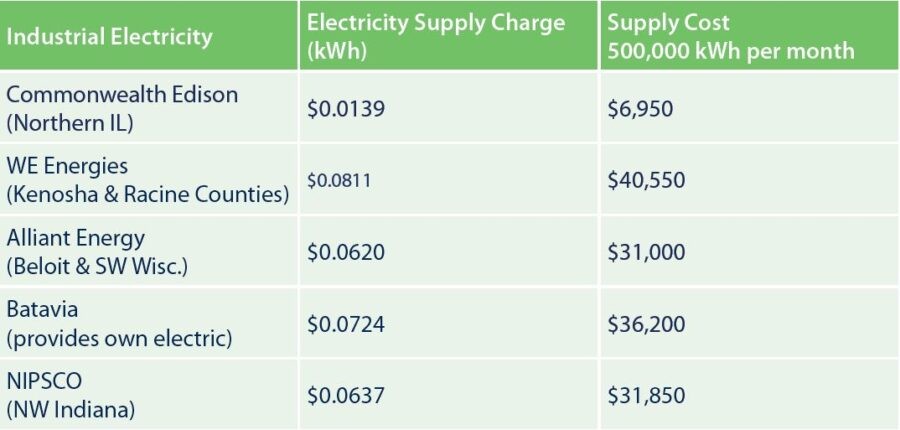Series on Costs of Running an Industrial Facility
Part II Cost of Utilities Across Chicagoland Market
Part I of this series focused on the cost of labor, which is one of the most expensive inputs of running any business. In this installment we’ll focus on something relatively minor to most companies but that can have a big impact on the bottom line of certain operations especially in the industrial arena. If you’re a manufacturing operation drawing down 500,000+ kWH per month the cost of electricity is likely a very important input. Likewise if you’re running a food processing, plastics, or pharmaceutical process you might be eating up north of 25,000 Therms a month. One of the cost inputs that often surprises people the most is water & sewer, which unlike gas & electricity changes from municipality to municipality and has a massive impact on the bottom line of a company with heavy water use (think bottled water plant, industrial laundry, food processing). We’ll take a brief look at each one, however, I’ll preface it by saying the numbers below are only a part of the picture. If you’ve ever looked closely at your utility bills there are a whole host of charges, connections fees, state, county, and municipal taxes, amongst others. What we are focusing on is the supply & distribution charges, which vary the most between different providers.
Electricity is actually the least variable of the three but ComEd charges the lowest supply charge of any of the providers in the Chicagoland market. On the supply component of your bill (which is what the electric provider charges for their services) 500,000 kWh would cost just under $7,000 will other utility providers could cost 4-5x more from a supply charge standpoint.

Natural gas like electricity has multiple components to the bill with most providers fixing the actual cost of the gas to the market price. The distribution charge is the most the variable component of the bill (along with local taxes and connection fees). Cheapest natural gas service provider in the Chicagoland market is NIPSCO, which covers most of NW Indiana.

Water & Sewer costs vary the most and the majority of the bill is actually the distribution charge. Each municipality provides their own water and the price varies wildly. For example Skokie is one of the few places that doesn’t charge a sewer component of the bill and as a result enjoys lower water/sewer rates than neighboring Evanston despite the fact that Skokie purchases their water from Evanston’s plant directly on the Lake. I attached a table below showing a few of the municipalities around town and the breadth of variety in water charges. A 2M gallon water user per month has the potential for a bill variability of $325,000 annually depending on where they operate their plant. In this case we advise clients the rent is really negligible (I’ve seen 2M galloon/month users in spaces as small as 50,000 SF which translates to $6.50 PSF in reduced occupancy cost). While we always negotiate the best rent deal possible for our clients the driving force behind this search would be a logistically and economically efficient municipality to reduce transportation and utility costs which will have a much more dramatic effect on the bottom line than we’d ever be able to negotiate through reduced rent at a slightly cheaper locale.

This summary is meant to be a preliminary exploration of some of the most variable costs associated with utilities and does not paint the entire picture (taxes, connection fees, etc.). Every situation is different and we run these analyses for our clients all the time. Give me a call and I can tailor a solution for you with a much more in depth dive into all the costs associated with running a plant.



